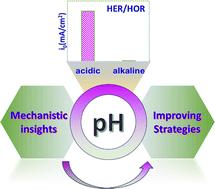当前位置:
X-MOL 学术
›
Chem. Soc. Rev.
›
论文详情
Our official English website, www.x-mol.net, welcomes your
feedback! (Note: you will need to create a separate account there.)
Insights into the pH effect on hydrogen electrocatalysis
Chemical Society Reviews ( IF 40.4 ) Pub Date : 2024-09-06 , DOI: 10.1039/d4cs00370e Wen-Gang Cui 1 , Fan Gao 1 , Guoquan Na 1 , Xingqiang Wang 1 , Zhenglong Li 1 , Yaxiong Yang 1 , Zhiqiang Niu 2 , Yongquan Qu 3 , Dingsheng Wang 4 , Hongge Pan 1, 5
Chemical Society Reviews ( IF 40.4 ) Pub Date : 2024-09-06 , DOI: 10.1039/d4cs00370e Wen-Gang Cui 1 , Fan Gao 1 , Guoquan Na 1 , Xingqiang Wang 1 , Zhenglong Li 1 , Yaxiong Yang 1 , Zhiqiang Niu 2 , Yongquan Qu 3 , Dingsheng Wang 4 , Hongge Pan 1, 5
Affiliation

|
Hydrogen electrocatalytic reactions, including the hydrogen evolution reaction (HER) and the hydrogen oxidation reaction (HOR), play a crucial role in a wide range of energy conversion and storage technologies. However, the HER and HOR display anomalous non-Nernstian pH dependent kinetics, showing two to three orders of magnitude sluggish kinetics in alkaline media compared to that in acidic media. Fundamental understanding of the origins of the intrinsic pH effect has attracted substantial interest from the electrocatalysis community. More critically, a fundamental molecular level understanding of this effect is still debatable, but is essential for developing active, stable, and affordable fuel cells and water electrolysis technologies. Against this backdrop, in this review, we provide a comprehensive overview of the intrinsic pH effect on hydrogen electrocatalysis, covering the experimental observations, underlying principles, and strategies for catalyst design. We discuss the strengths and shortcomings of various activity descriptors, including hydrogen binding energy (HBE) theory, bifunctional theory, potential of zero free charge (pzfc) theory, 2B theory and other theories, across different electrolytes and catalyst surfaces, and outline their interrelations where possible. Additionally, we highlight the design principles and research progress in improving the alkaline HER/HOR kinetics by catalyst design and electrolyte optimization employing the aforementioned theories. Finally, the remaining controversies about the pH effects on HER/HOR kinetics as well as the challenges and possible research directions in this field are also put forward. This review aims to provide researchers with a comprehensive understanding of the intrinsic pH effect and inspire the development of more cost-effective and durable alkaline water electrolyzers (AWEs) and anion exchange membrane fuel cells (AMFCs) for a sustainable energy future.
中文翻译:

深入了解 pH 值对氢电催化的影响
氢电催化反应,包括析氢反应 (HER) 和氢氧化反应 (HOR),在各种能量转换和储存技术中发挥着至关重要的作用。然而,HER 和 HOR 显示出异常的非 Nernstian pH 依赖性动力学,与酸性介质相比,碱性介质中的动力学缓慢是 2 到 3 个数量级。对本征 pH 效应起源的基本理解引起了电催化界的极大兴趣。更关键的是,对这种效应的基本分子水平理解仍然存在争议,但对于开发活性、稳定且负担得起的燃料电池和水电解技术至关重要。在此背景下,在本文中,我们全面概述了 pH 值对氢电催化的内在影响,包括实验观察、基本原理和催化剂设计策略。我们讨论了各种活性描述符的优缺点,包括氢结合能 (HBE) 理论、双功能理论、零自由电荷电位 (pzfc) 理论、2B 理论和其他理论,跨越不同的电解质和催化剂表面,并在可能的情况下概述了它们的相互关系。此外,本文还重点介绍了利用上述理论通过催化剂设计和电解质优化来改善碱性 HER/HOR 动力学的设计原则和研究进展。最后,还提出了关于 pH 对 HER/HOR 动力学影响以及该领域面临的挑战和可能的研究方向的剩余争议。 本综述旨在为研究人员提供对内在 pH 效应的全面理解,并激发开发更具成本效益和耐用性的碱性水电解槽 (AWE) 和阴离子交换膜燃料电池 (AMFC),以实现可持续能源的未来。
更新日期:2024-09-06
中文翻译:

深入了解 pH 值对氢电催化的影响
氢电催化反应,包括析氢反应 (HER) 和氢氧化反应 (HOR),在各种能量转换和储存技术中发挥着至关重要的作用。然而,HER 和 HOR 显示出异常的非 Nernstian pH 依赖性动力学,与酸性介质相比,碱性介质中的动力学缓慢是 2 到 3 个数量级。对本征 pH 效应起源的基本理解引起了电催化界的极大兴趣。更关键的是,对这种效应的基本分子水平理解仍然存在争议,但对于开发活性、稳定且负担得起的燃料电池和水电解技术至关重要。在此背景下,在本文中,我们全面概述了 pH 值对氢电催化的内在影响,包括实验观察、基本原理和催化剂设计策略。我们讨论了各种活性描述符的优缺点,包括氢结合能 (HBE) 理论、双功能理论、零自由电荷电位 (pzfc) 理论、2B 理论和其他理论,跨越不同的电解质和催化剂表面,并在可能的情况下概述了它们的相互关系。此外,本文还重点介绍了利用上述理论通过催化剂设计和电解质优化来改善碱性 HER/HOR 动力学的设计原则和研究进展。最后,还提出了关于 pH 对 HER/HOR 动力学影响以及该领域面临的挑战和可能的研究方向的剩余争议。 本综述旨在为研究人员提供对内在 pH 效应的全面理解,并激发开发更具成本效益和耐用性的碱性水电解槽 (AWE) 和阴离子交换膜燃料电池 (AMFC),以实现可持续能源的未来。


















































 京公网安备 11010802027423号
京公网安备 11010802027423号